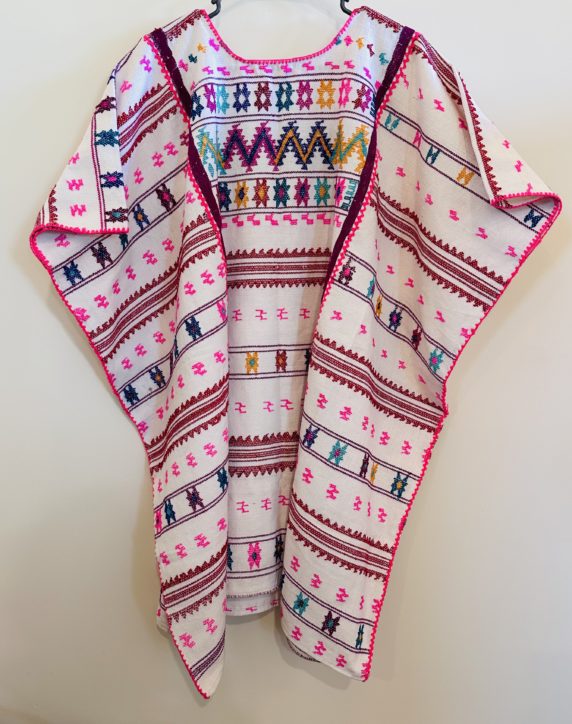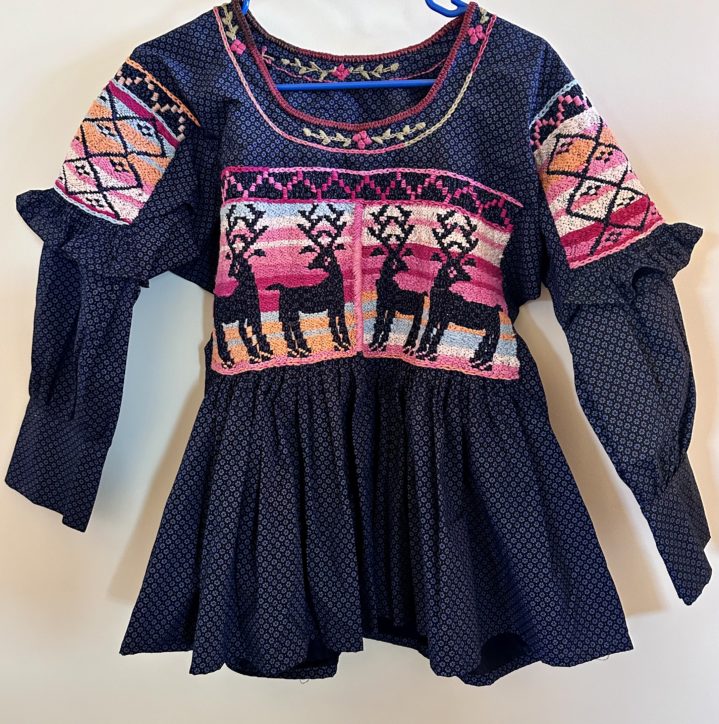Carolyn Kallenborn worked with Eric Chavez Santiago, director of education at the Museo Textil de Oaxaca to offer a natural dye workshop in the technique of bound resist or “tenido de reserva.” Attendees included indigenous weavers, artists and expatriates from the U.S. and Canada who live in Oaxaca. Carolyn is assistant professor at the University of Wisconsin-Madison. Her contact information is at the end of this post. We have been working together to organize weaving and natural dyeing workshops for university students in the home of Eric’s parents in Teotitlan del Valle. I asked her if I could publish this workshop experiences (which she just shared with friends and colleagues) and photos. She happily agreed.
***
I just got back Tuesday night from a couple of weeks in Oaxaca just in time for some of the coldest temperatures here in WI on record. They say it is supposed to get down to *minus 27 degrees Fahrenheit* tonight. Brrrr. But as I look through the photos and think about the time I just spent in Mexico, it helps me feel a little warmer.
See a complete photo library of the bound resist natural dye workshop at
http://www.facebook.com/album.php?aid=58355&l=1dc92&id=656399116
This year, perhaps because I am at a new school, perhaps because of the financial crunch, I didn’t get enough students to lead a trip to Oaxaca this year. So I took the opportunity to work with the new Textile Museum in Oaxaca ( http://www.museotextildeoaxaca.org.mx/) and offered a workshop to some very talented weavers from the Oaxaca area. It was a big milestone for me in that it was the first time I have taught a class all in Spanish (translated directions, converted from TBS to grams (they use weight rather than measuring spoons) and Fahrenheit to Celsius) so it was a bit of a challenge. But very fun.

Weaving by Elsa Abigail Mendoza Antonio
I taught a four day class in Bound Resist (Teñidos de Reserva) using natural dyes, and discharge (color removal) on cotton and linen. They had a wonderful exhibit up at the museum on bound resists from all over the world, including a patola from India and double ikat from Japan, adire oniko from Nigeria and wonderful Mexican bound resist from the 20’s. It was great to be able to go into the museum to look at pieces multiple times during the workshop to look at some of the best examples from around the world.

Bound Resist with Indigo, Mexico 1920’s
I also brought along a lot of my own dyed fabrics and pieces that I have collected. Unlike the ones in the museum exhibit, we could touch and fold these. Some of the students had done some dyeing but all had been working with textiles their whole lives. It was amazing to see how quickly they understood the processes as I described them. And they were excited to be learning something very different than anything they had done before.

Demonstrating folding and clamping
We spent three days working in with stitched resist, cochineal for red, pericón for yellow, indigo for blue and Thiox to remove color.

Indigo workshop area

Bound resist in pericón and indigo and Indigo dyed yarn
I brought along some wooden clamps that I had my friend Paul cut out for me. We used these to compress the fabric tight enough so that the dye could not penetrate between the clamps. With these, they made some beautiful designs.


 Photos Left to right:
Photos Left to right:
Eufrosina Vásquez López Fabric by Eric Chavez Santiago Line of fabrics drying
On the last night, I gave public lecture (also in Spanish – a bit scary but fun to have made it through!) on my own art work, the projects that I have been doing with the weavers in Oaxaca and talked about the work we did in the workshop. It seemed to go really well and I think everyone understood me. No one feel asleep and people seemed to laugh at the right places.
The museum set up a display of the pieces that the students made during the workshop. After the lecture, the students talked to the guests about what they did and explained the processes. I don’t know what more they will do with this, but several of them were asking questions about how to do specific projects that they were thinking of. So I am hoping that when I go back again, some of them may have some pieces to show.


One of 4 display tables View of workshop area from museum
Reporters from two local newspapers showed up. I was able to get a copy of one of the articles, but the other came out after I already left. (If you can read Spanish, it is on the web at: http://www.imparcialenlinea.com/index.php?mod=leer&id=70451&sec=cultura&titulo=Intercambian_culturas_a_trav%E9s_de_te%F1idos
Though I don’t think those are direct quotes. The Spanish usage seems much too complex to be anything I actually said.)
All in all, it was a really great experience. It was wonderful to work with such a talented group of artists and with the fabulous staff at the Textile Museum in Oaxaca.
Special thanks to Eric Chavez Santiago for helping to organize everything and who gave wonderful information on natural dyes. Photos are courtesy of Carolyn Kallenborn and Eric Chavez Santiago.
Carolyn Kallenborn
Assistant Professor
Design Studies
University of Wisconsin – Madison
1300 Linden Drive
Madison WI 53706
608-233-1432
cmkallen@wisc.edu
www.carolynkallenborn.com
Like this:
Like Loading...








 Photos Left to right:
Photos Left to right:







Weaving a Curve: A Documentary Short Film
Eric Chavez Sosa and I made this six minute short documentary film during the January 31-February 6 workshop held by Oaxaca Cultural Navigator LLC in Teotitlan del Valle. It was our first film making collaboration and we were definitely novices! Here it is:
http://www.youtube.com/watch?v=8UHCPpaap3E
“Weaving a Curve” featuring master weaver Federico Chavez Sosa. He talks about the techniques he learned from his father and another village master who taught him to weave in the style of Francisco Toledo. At the age of 17, Federico was an expert weaver. To weave a curve and perfect the technique requires discipline and practice. He remembers taking the yarn out and trying again, and again, and again. Federico loves to weave, and the process for him is both relaxing and fun. He also explains how he uses natural dyes to prepare the wool, another sign of a master weaver. As the camera pans the village and the sacred Zapotec site of mount Picacho, Federico talks about the meaning of weaving for him personally and how satisfying it is when his work is appreciated by collectors. For Federico, mastery means the blending of traditional and contemporary designs, the true mark of an artist, and the timeless quality of linking past with future.
Eric and I didn’t have time to finish this piece — it is in Spanish without subtitles. So, please forgive us and enjoy the visuals if you don’t completely understand the language. Maybe someday soon, we’ll add the subtitles!
I also want to acknowledge the mastery of our workshop instructors, Erica Rothman of Nighlight Productions, Durham, NC, and Mikel Barton, also of Durham. They were fabuloso!
The process: for five days were were immersed in a learning laboratory experience in the village of Teotitlan del Valle, Oaxaca. We after two days of classroom instruction and watching examples of documentary footage, we took to the cameras to practice interview techniques and shooting b-roll. We had 60 minutes of tape to use with the goal of producing a 3-5 minute finished video. Unfortunately for us, we used about 20 minutes to practice shooting b-roll which turned out mostly to be sunrise and clouds. You can see a snippet in our opening scene.
Like this:
1 Comment
Posted in Cultural Commentary
Tagged documentary filmmaking, documentary photography, Eric Chavez Santiago, Federico Chavez Sosa, Mexico, Norma Hawthorne, Oaxaca, Teotitlan del Valle, weaving a curve, Zapotec weaving